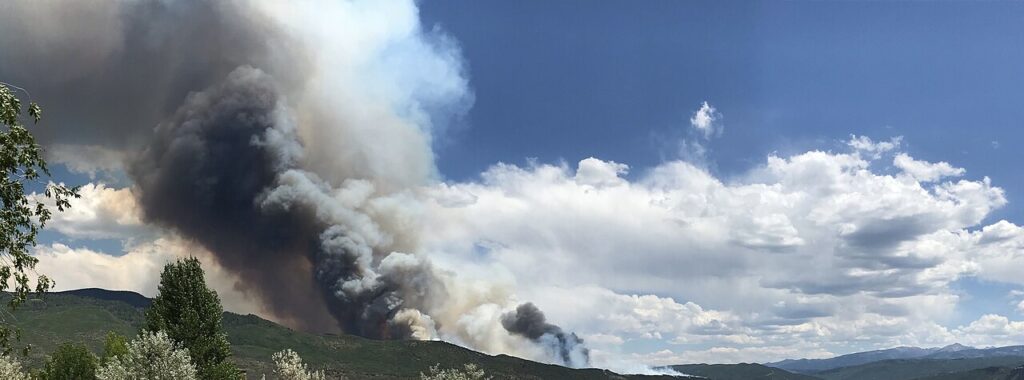Are Forest Fires a New War Crime against Natural Heritage?
The use of forest fires as a weapon in warfare and terrorism underscores the need for a vigilant and multifaceted approach to national and global security.
On February 24, 2022, the Russian Federation initiated a large-scale military invasion of Ukraine, resulting in widespread destruction and contamination in southern and eastern parts of the country. Over the following year and a half, vast areas were subjected to intense artillery shelling, leading to significant environmental impacts. Unexploded ordnance (UXO), wildfires, and pollution have become major concerns in the conflict-affected regions. UXO contamination has been particularly pronounced, with fires caused by shelling-related ignition being a frequent cause of forest disturbance in the area. The difficulty of conducting fire suppression operations in isolated rural areas, amid ongoing battles, and UXO contamination have further exacerbated the situation.

The extent of environmental damage inflicted upon Ukrainian territory by Russian aggression is vast, although its full magnitude remains unclear due to the ongoing conflict. However, it is clear that the impact has been substantial, with long-lasting effects on the environment and local populations.
According to the Ukrainska Pravda website ” A pre-trial investigation has been launched in criminal proceedings with respect to a violation of the laws and customs of war (Art. 438.1 of the Criminal Code of Ukraine) under the procedural guidance of prosecutors from the Specialist Environmental Prosecutor’s Office of the Donetsk Oblast Prosecutor’s Office.” It seems that, on 7 May 2024, Russian forces shelled the territory of the Yampil Forest with artillery. Trees and the forest floor caught fire as a result of being hit by munitions“.
If the allegations were verified, the use of forest fires in Ukraine as a weapon of war would be only the latest case. According to the Guardian, Russia’s top security official said in 2012 that al-Qaida was waging a “forest jihad” in Europe, sparking the fires that have ravaged the continent in recent summers. Unfortunately, forest fire prevention has much less effective tools than those used in buildings. There are no automatic fire extinguishing systems and even those that can be used once the fire has started are much less effective than would be necessary.
But forest fires set for war reasons are nothing new. Therefore, it is not surprising that even in recent times there have been cases of forest fires that have suspiciously or evidently been caused by malicious intent, linked to war reasons.
According to Prof. J.R. McNeill (Georgetown University) in his essay Forests and Warfare in World History:
The ancient Assyrians, like many more recent armies, deliberately burned the woodlands of their enemies. Armies often caused forest fires entirely by accident as well. Indeed the Roman writer of the 1st century B.C. Lucretius listed armies among his three reasons behind forest fires (hunting parties and lightning were the others). For most of human history, war could not do much damage to forests except where burning was possible. In the more humid forests of northern Europe where fires were rare, for example, prolonged warfare, as in the Hundred Years War or the Thirty Years War, could lead to the spontaneous resurgence of forests because it reduced population, and thus both the area under the plow and fuelwood demand.
Here are some more recent cases where forest fires have been used as a tactic in warfare or by terrorists:
Historical and Warfare-Related Forest Fires
World War II:
During the war, both Axis and Allied forces used fire as a weapon. For instance, incendiary bombs were dropped on forested areas to destroy enemy resources and infrastructure. The bombings of Dresden and Tokyo also caused massive urban and forest fires.
Vietnam War (1960s-1970s):
The U.S. military used incendiary bombs and defoliants like Napalm and Agent Orange to destroy forest cover and crops, depriving the Viet Cong and North Vietnamese forces of food and concealment. These actions caused extensive deforestation and long-term ecological damage.
Algeria War (1956-1962):
According “Analysis of forest fires causes and their motivations in northern Algeria: the Delphi method“: During the Algerian war, many wildfires were actually voluntarily started as scorched earth policy, the military strategy of destroying anything useful to the enemy. Napalm bombing was also occasionally used by the French Air Army to force out revolutionary groups who sought shelter in the forests in an attempt to deprive them of food and cove.
Terrorism and Arson-Related Forest Fires
Greece (2007):
During the summer of 2007, Greece experienced devastating wildfires, some of which were believed to be started by arsonists. While motives varied, including land speculation, there were suspicions of politically motivated arson aimed at destabilizing the government.
Australia (2009):
The Black Saturday bushfires in Victoria, Australia, which killed 173 people and caused widespread destruction, included instances where arson was confirmed. While not all were linked to terrorism, the catastrophic impact highlighted the potential for arson to be used as a weapon.
Israeli-Palestinian Conflict (2016):
The 2020 wildfire season in California saw several instances where arson was suspected. While not all were linked to terrorism, the deliberate setting of fires during a period of extreme vulnerability raised concerns about the potential for such tactics to be used in future terror attacks.
California Wildfires (2020):
A series of forest fires in Israel during November 2016 were suspected to be acts of arson with a political motive. While some fires were started accidentally, others were believed to be set deliberately by individuals or groups seeking to create chaos and damage.
Turkey (2021):
In 2021, Turkey experienced a series of severe forest fires, and there were allegations that some of these fires were started deliberately by Kurdish militants (PKK) as a form of asymmetric warfare.
Contemporary Potential Threats
Mediterranean Region:
Various Mediterranean countries, including Greece, Turkey, and Italy, have reported instances of forest fires suspected to be arson-related, with potential links to both local disputes and broader political tensions.
United States:
In recent years, the U.S. has faced concerns about the potential for terrorists to use arson as a tactic, particularly in the context of increasing wildfire frequency and severity due to climate change.
The impacts of using forest fires as weapons are multifaceted and severe. Environmentally, forest fires result in the destruction of vast tracts of vegetation, loss of wildlife habitats, and long-term soil degradation. The immediate aftermath often includes air pollution from smoke and ash, contributing to respiratory problems in humans and animals alike.
Economically, the cost of fighting large-scale forest fires is enormous. Resources are diverted to firefighting efforts, and the destruction of timber, crops, and infrastructure leads to significant financial losses. Communities may be displaced, leading to long-term economic instability and recovery challenges.
Psychologically, the fear and uncertainty generated by forest fires can have a profound impact on affected populations. The sight of advancing flames, the loss of homes, and the unpredictability of fire behavior contribute to a sense of helplessness and trauma. This psychological toll can be particularly acute in areas that experience repeated or prolonged fire seasons.
Addressing the threat of forest fires as a weapon requires a comprehensive approach that includes prevention, detection, and response strategies. Prevention efforts focus on reducing the risk of fire ignition through controlled burns, clearing of flammable vegetation, and public education on fire safety. Enhancing surveillance and intelligence capabilities can help detect and deter potential arsonists, whether they are terrorists or individuals with other motives..




